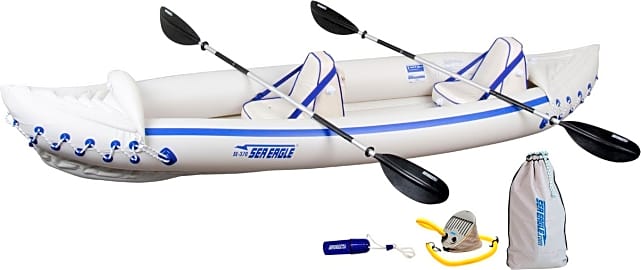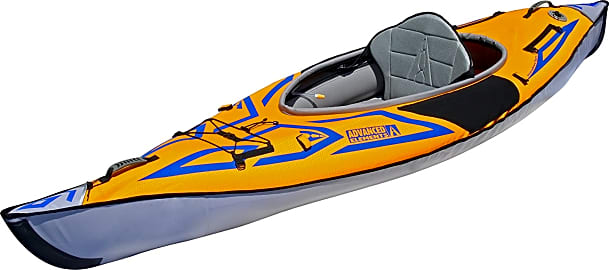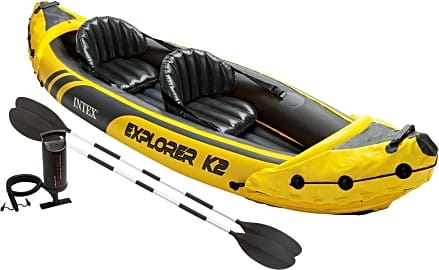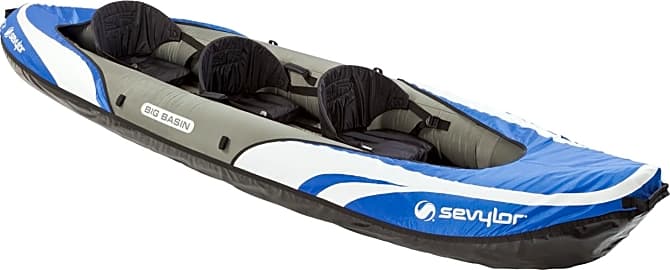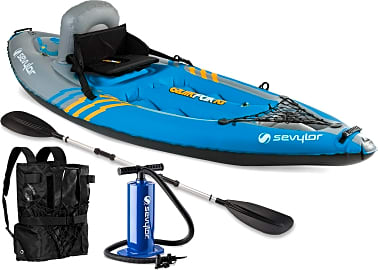The 8 Best Inflatable Kayaks

This wiki has been updated 41 times since it was first published in September of 2015. While hitting the water in a blow-up boat may seem questionable at first, these inflatable kayaks are actually quite durable and sturdy. They're easy to store and transport, so you can get them to the lake without having to tow a trailer or strap them to a rack on your vehicle. As with any vessel, make sure to practice caution and always have a life preserver for each passenger onboard. When users buy our independently chosen editorial recommendations, we may earn commissions to help fund the Wiki.
Editor's Notes
July 29, 2021:
We opted to bump one from Solstice and one from Airhead due to availability concerns, as well as a previous popular pick, the StraightEdge, because some users had long-term reliability issues. Our newcomer, the Oru Beach LT, lands right at the number one spot because it's not actually inflatable. Instead, it's made with remarkably durable materials and designed to unfold from the size of a large suitcase into a full-size kayak. If you prefer something a slightly different size, the rest of Oru's lineup almost certainly has something for you.
July 17, 2020:
Removed three items from the list. While the Sevylor Quikpak K1 is a decent value, we’ve pointed out that it doesn’t track as efficiently as some other models, and the included paddle isn’t top quality. Adjusted the listing for the Airhead Deluxe to highlight its vibrant, highly visible design, UV-resistant protective coating, and useful grab handles that make it easy to place into the water or pull it out when you’re done kayaking.
Regarding the Advanced Elements AdvancedFrame Sport, we indicated that its ribbed design lends it significant rigidity, and it offers a helpful storage compartment for keeping snacks and personal items close at hand. This is a high-quality option, but you should keep in mind that it’s designed for users who are about six feet tall or shorter; taller individuals will likely feel cramped in this kayak.
Added three new replacement items. The Solstice Durango is a sturdy, dog-friendly kayak that can accommodate up to two people. We’ve noted that it comes with a repair kit. The Advanced Elements StraitEdge is a kayak for anglers, with built-in rod holders and reliable stability that allows folks to maintain their balance when unhooking fish. Its ruggedness is particularly impressive; it can handle rough conditions, and its thick surface is very resistant to punctures.
April 18, 2019:
Our top choice from last year's ranking has maintained its spot at number one, thanks mainly to its incredibly sleek design and particularly durable construction, as well as its impressive 250-pound capacity combined with a very light carrying weight of just 26 pounds. Our previous number two selection wasn't so lucky, dropping down to the fifth slot primarily because it's not terribly easy to steer due to symmetrical issues in the inflation of its inner bladder. The Sevylor Big Basin also took a bit of a dive due to how slowly its exterior takes to dry out. This can get particularly tiresome once you're off the water and looking to pack up and head home.
Special Honors
Karve Kayak The versatile hybrid design of the Karve Kayak gives you two options: sit in its cozy cockpit, or stand and utilize it as a paddleboard. It’s built to provide super reliable tracking, with a narrow bow and a wide area behind the seat. It comes with a heavy-duty transport bag, too. paddlenorth.com
Wing Inflatable Solutions Wing’s dynamic whitewater kayak — charmingly named Jimbo — is robust enough to handle rough rapids, but lightweight enough to carry into remote areas. It’s available in a wide variety of colors, and it contains 10 D-ring attachments. Handles at both ends are useful for pulling it out of the water. inflatablesolutions.com
A Brief History Of The Kayak
The term is a derivation of the native word qajaq, pronounced kah-djak, and which can be traced back across many centuries.
The word kayak comes from a Greenlandic language closely related to the traditional tongue shared by the Inuit and Aleuts of North America. The term is a derivation of the native word qajaq, pronounced kah-djak, and which can be traced back across many centuries. Kayaks have long been used by these denizens of the frozen northlands both for hunting and travel.
The original kayaks were made primarily of seal skin (and occasionally from the hides of other animals) stitched together and then stretched over a frame made out of whale bones or, when it was available, wood. Kayaks have likely been in use for more than 4,000 years and examples of these hearty, resilient boats are still made in the original manner today, though almost exclusively for demonstration purposes, not for practical daily use.
By the early half of the 20th Century, wooden frames and fabric hulls had come to be common in kayak design, but in the 1950s, the advent of practical, easy to use fiberglass saw this material briefly dominant in kayak construction. The use of fiberglass would see a decline almost as quickly as it had become ascendant, however, as in the early 1970s molded plastic kayaks quickly became the most popular units available.
Plastic kayaks were smaller, stronger, and more affordable than fiberglass boats, and they could be made in a wider variety of shapes and sizes, ushering in the era of freestyle paddling that has gained enough popularly today to be an Olympic sport.
Today, kayaking is enjoyed by millions of people all over the globe, with different boat designs offering the chance for an ocean adventure, a white water ride, or a trip down a lazy river. Kayaks are used by some people as their preferred means for daily commuting and by others while out on a fishing trip. If you are interested in kayaking, you will also be interested to know that the hobby can be an affordable one to commence, especially when you consider an inflatable kayak.
In recent years, these plucky boats have seen a marked increase in popularity, especially with urban residents who have limited storage space but still want to own a great, compact boat.
An Inflatable Kayak Fit For Fun
You will be pleasantly surprised at how very little an inflatable kayak that's actually of very good quality can cost. There are many inflatable kayaks that don't cost a fortune, and these little boats often come complete with paddles and pumps, no less. Choosing an inflatable kayak starts with considering who will use it.
If you are getting a boat that will only be for yourself or another person, than a one person kayak is fine.
If you are getting a boat that will only be for yourself or another person, than a one person kayak is fine. But keep in mind that even many two seat kayaks can easily be controlled by one person, so if you want the option to occasionally paddle along with a friend, consider a two person boat even if you will often use it solo.
Next consider where you will primarily be using your kayak. If you will use the boat only in lakes and on calm rivers, then you can hardly make a poor choice.
If the kayak will encounter the occasional rapids, then you need to factor in extra durability and puncture resistance. Look for kayaks with semi rigid hulls that can handle impacts with rocks, submerged logs, and other obstacles that tend to hide beneath white water.
If your kayak will be used in the open water of a bay or the sea, then stability is an important factor what with waves and boat wake. A longer, wider boat can help you stay upright under these conditions, and can help you bring along some food, water, and other supplies you might want during a longer outing as well.
The Inflatable Kayak Ready For Adventure
Believe it or not, there are inflatable kayaks ready for everything from a use during a fishing trip to use during a run down rapids to use in the frigid waters of the Arctic Circle. Top of the line inflatable kayaks can compete with standard rigid-bodied kayaks in almost every respect, though you will have to be ready to pay quite a bit for these quality options.
When you rapidly get yourself rightsize up and still have a kayak that's dry inside, you can safely continue on your exciting journey.
When selecting a kayak for use during a fishing trip or for use during the course of many days, such as with a camping trip featuring river travel, you need a boat that can handle plenty of weight and that offers excellent stability. That usually means a larger kayak that might not be as nimble when shooting through rapids or making quick turns on open water, but you need to be ready to sacrifice some performance in the name of payload capacity and in reduced likelihood of capsizing.
For plying frosty waters or for paddling your way through whitewater, you need a kayak with a cockpit you sit down in and which can accommodate a skirt, commonly called a spray deck. Only when you are securely strapped into your boat with a water tight seal created around the cockpit can you safely run through rapids without the risk of taking on water. This same seal helps to keep you safely insulated in icy waters, especially if your boat tips over. When you rapidly get yourself rightsize up and still have a kayak that's dry inside, you can safely continue on your exciting journey.


